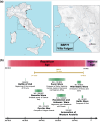A New Perspective on the Arrival of the Eastern Mediterranean Genetic Influx in Central Italy Before the Onset of the Roman Empire
- PMID: 40720742
- PMCID: PMC12321521
- DOI: 10.1093/gbe/evaf149
A New Perspective on the Arrival of the Eastern Mediterranean Genetic Influx in Central Italy Before the Onset of the Roman Empire
Abstract
Italian genetic history was profoundly shaped by the Romans. While the Iron Age Central Italian gene pool was comparable to that of other coeval Central/Western European regions, during the Imperial age, it was significantly influenced by Eastern Mediterranean ancestries. To explain this genetic shift, it has been proposed that people from eastern provinces of the Empire migrated toward its political center: Rome and its surroundings. In this study, by presenting a new Roman Republic individual (1.25×) and comparing it to other published Republican samples, we propose a novel perspective for the presence of the Eastern Mediterranean ancestry in the Imperial gene pool. We show that the spread of this genetic ancestry may have taken place earlier than previously thought, during the Late Republican period, therefore predating the onset of the Empire by ∼200 years. The diffusion of this ancestry occurred due to early East-to-West movements, either because Eastern Mediterranean regions were under Roman political influence since the Late Republican period or even as a result of internal movements from Southern Italy where several Greek and Phoenician settlements were established during the 1st millennium BCE.
Keywords: Central Italy; Eastern Mediterranean; Roman Republic; ancient DNA; archaeogenetics.
© The Author(s) 2025. Published by Oxford University Press on behalf of Society for Molecular Biology and Evolution.
Figures



Similar articles
-
The Black Book of Psychotropic Dosing and Monitoring.Psychopharmacol Bull. 2024 Jul 8;54(3):8-59. Psychopharmacol Bull. 2024. PMID: 38993656 Free PMC article. Review.
-
Punic people were genetically diverse with almost no Levantine ancestors.Nature. 2025 Jul;643(8070):139-147. doi: 10.1038/s41586-025-08913-3. Epub 2025 Apr 23. Nature. 2025. PMID: 40269169 Free PMC article.
-
[Volume and health outcomes: evidence from systematic reviews and from evaluation of Italian hospital data].Epidemiol Prev. 2013 Mar-Jun;37(2-3 Suppl 2):1-100. Epidemiol Prev. 2013. PMID: 23851286 Italian.
-
A genetic history of continuity and mobility in the Iron Age central Mediterranean.Nat Ecol Evol. 2023 Sep;7(9):1515-1524. doi: 10.1038/s41559-023-02143-4. Epub 2023 Aug 17. Nat Ecol Evol. 2023. PMID: 37592021
-
Prophylactic non-steroidal anti-inflammatory drugs for the prevention of macular oedema after cataract surgery.Cochrane Database Syst Rev. 2016 Nov 1;11(11):CD006683. doi: 10.1002/14651858.CD006683.pub3. Cochrane Database Syst Rev. 2016. PMID: 27801522 Free PMC article.
References
-
- Abulafia D. The great sea: a human history of the Mediterranean. Oxford University Press; 2011.
Publication types
MeSH terms
Substances
Grants and funding
LinkOut - more resources
Full Text Sources

